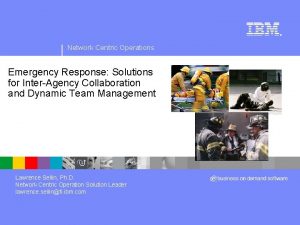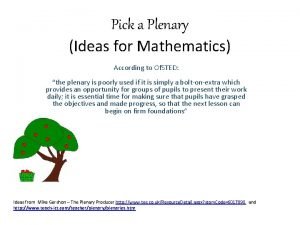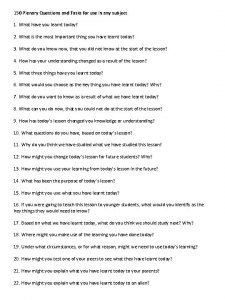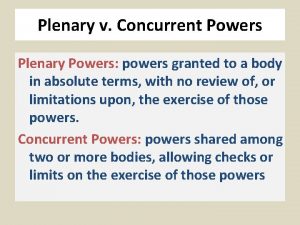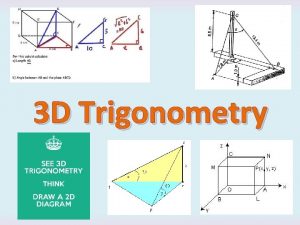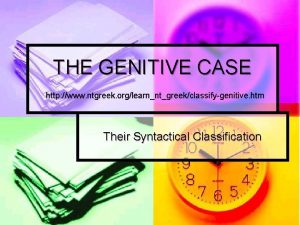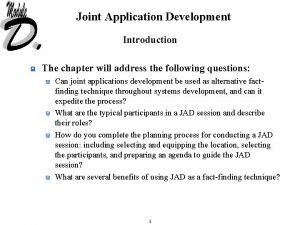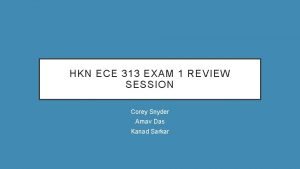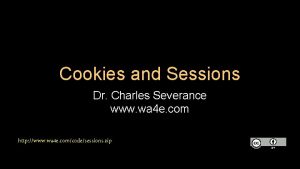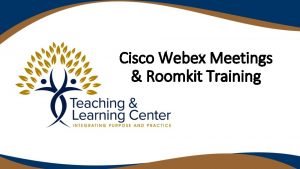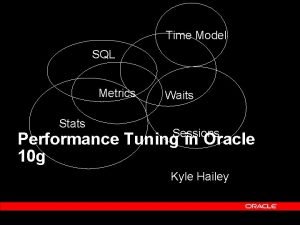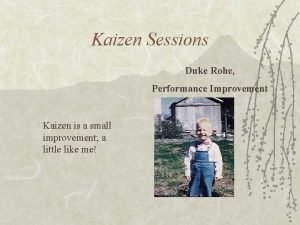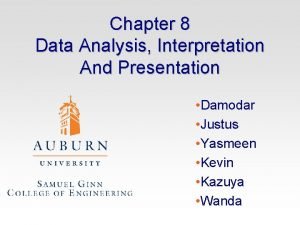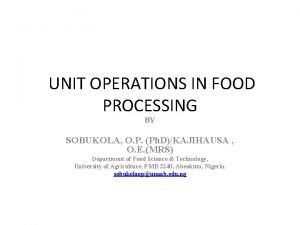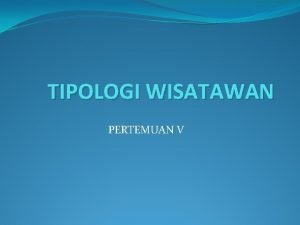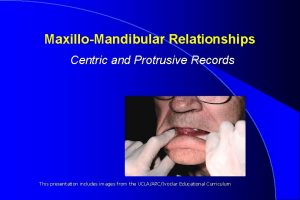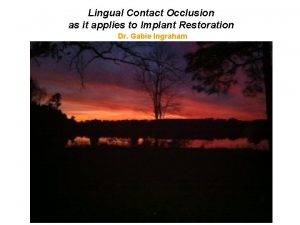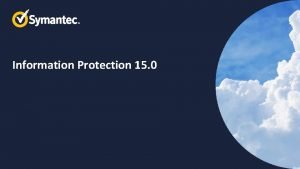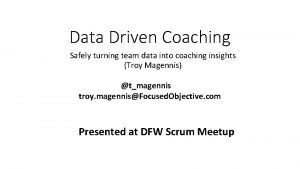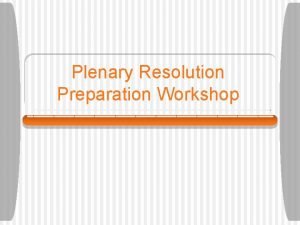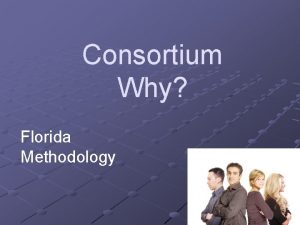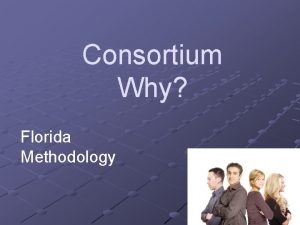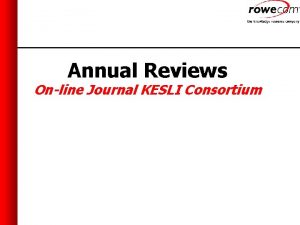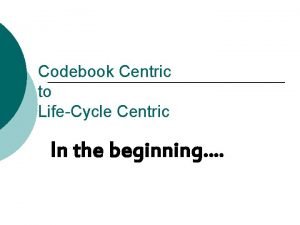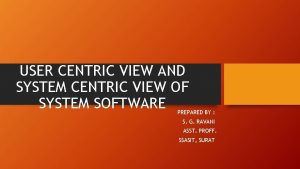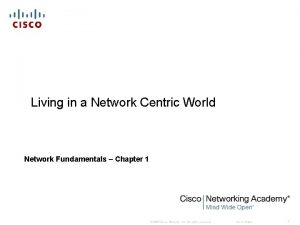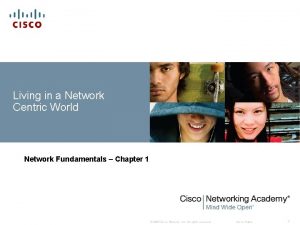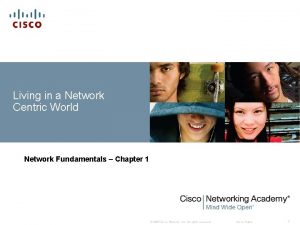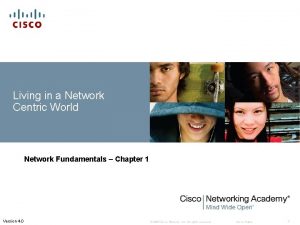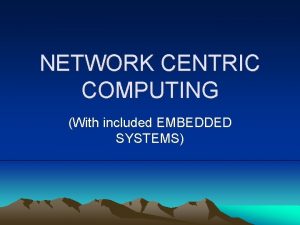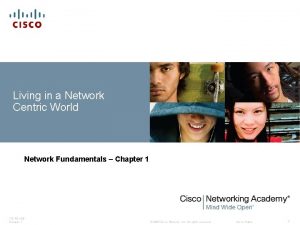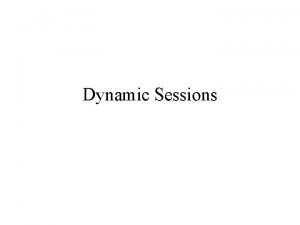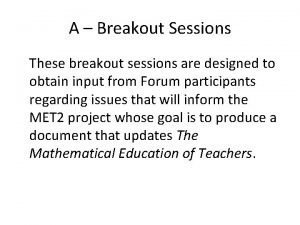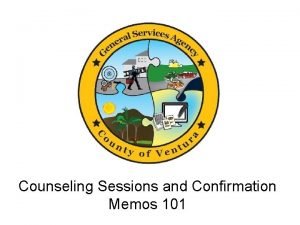Network Centric Operations Industry Consortium Summer Plenary Sessions


























- Slides: 26

Network Centric Operations Industry Consortium Summer Plenary Sessions: Semantic Interoperability Workshop, John Yanosy, Chair Brand Niemann (US EPA), Co-Chair, Semantic Interoperability Community of Practice (SICo. P) Best Practices Committee (BPC), CIO Council August 1, 2006 Hyatt Regency Reston, Virginia 1

My Background • US EPA Office of the Chief Information Officer and Environmental Information, Enterprise Architecture Team: – EPA Data Architecture for DRM 2. 0 • Federal Chief Information Officer Council, Data Reference Model 2. 0: – Lead for Implementation Through Testing & Iteration • Federal CIO Council’s Two Committees: – Co-Chair, SOA Community of Practice • First SOA for E-Government Conference, May 23 -24, 2006 – Co-Chair, SICo. P • Semantic Interoperability Community of Practice – World Wide Web Consortium’s Semantic Web Standards and Semantic Agents 2

SICo. P • Charter (March 2004): – The Semantic Interoperability Community of Practice (SICo. P) is established by a group of individuals for the purpose of achieving "semantic interoperability" and "semantic data integration" focused on the government sector. The SICo. P seeks to enable Semantic Interoperability, specifically the "operationalizing" of these technologies and approaches, through online conversation, meetings, tutorials, conferences, pilot projects, and other activities aimed at developing and disseminating best practices. (Only Excerpt) • Co-Chairs (Non-government and Government): – Mills Davis, Project 10 X. Com, and Brand Niemann, US EPA • Web Presence: – Web Site, Conventional Wiki, and Test Semantic Wiki • Activities: – White Papers (2), Conferences (4), Projects (6), and Pilot Projects (many) in Support of the Federal Enterprise Architecture, Agencies, Programs, and now European Semantic. Gov Project Consortium. 3

SICo. P • One of Those Projects Was the DRM: – December 2004, DRM 1. 0 – Just structured data (Description) and exchange packages (Sharing). – February 2005, SICo. P White Paper 1 (“Data Architecture of the Future”) – All three types of data (Description) and ontologies (Context). – October 2005, SICo. P DRM 2. 0 Implementation Guide – Metamodel and Semantic Metadata (see slides 5 - 6). – December 2005, DRM 2. 0 – Description (3), Context (2), and Sharing (2) (see slide 7). • So DRM 2. 0 + Semantic Metadata = SICo. P Knowledge Reference Model (KRM). • DRM 2. 0 Implementation Evolves to the SICo. P Semantic Wikis and Information Management (SWIM) WG 4

Data Reference Relationships Modeland 2. 0 associations • Metamodel: Precise definitions of constructs and rules needed for abstraction, generalization, and semantic models. • Model: Relationships between the data and its metadata. • Metadata: Data about the data. • Data: Facts or figures from which conclusions can be inferred. Source: Professor Andreas Tolk, August 16, 2005 The purpose of this schematic is to show that we need to describe information model relationships and associations in a way that can be accessed and searched. 5

Data Reference Model 2. 0 The point of this graph is that Increasing Metadata (from glossaries to ontologies) is highly correlated with Increasing Search Capability (from discovery to reasoning). 6

Data Reference Model 2. 0 DRM 1. 0 All Three SICo. P Ontologies Source: Expanding E-Government, Improved Service Delivery for the American People Using Information Technology, December 2005, pp. 2 -3. http: //www. whitehouse. gov/omb/budintegration/expanding_egov_2005. pdf 7

Data Reference Model 2. 0 • Summary: – Slide 5: We need to describe information model relationships and associations in a way that can be accessed and searched. – Slide 6: Increasing Metadata (from glossaries to ontologies) is highly correlated with Increasing Search Capability (from discovery to reasoning). – Slide 7: Three things about data (Description, Context, and Sharing) are needed for information sharing. 8

Data Reference Model 2. 0 • The FEA framework and its five supporting reference models (Performance, Business, Service, Technical and Data) are now used by departments and agencies in developing their budgets and setting strategic goals. With the recent release of the Data Reference Model (DRM), the FEA will be the “common language” for diverse agencies to use while communicating with each other and with state and local governments seeking to collaborate on common solutions and sharing information for improved services. Source: Expanding E-Government, Improved Service Delivery for the American People Using Information Technology, December 2005, pages 2 -3. http: //www. whitehouse. gov/omb/budintegration/expanding_egov_2005. pdf 9

Data Reference Model 2. 0 • The preceding chart (slide 7) illustrates the potential uses of the newly released DRM Version 2. 0: – The FEA mechanism for identifying what data the Federal government has and how it can be shared in response to a business/mission requirement. – The frame of reference to facilitate Communities of Interest (which will be aligned with the Lines of Business) toward common ground and common language to facilitate improved information sharing. – Guidance for implementing repeatable processes for sharing data Government-wide. Source: Expanding E-Government, Improved Service Delivery for the American People Using Information Technology, December 2005, pages 2 -3. 10 http: //www. whitehouse. gov/omb/budintegration/expanding_egov_2005. pdf

Data Reference Model 2. 0 • Reference Model: – A reference model is an abstract framework for understanding significant relationships among the entities of some environment that enables the development of specific architectures using consistent standards or specifications supporting that environment. – A reference model consists of a minimal set of unifying concepts, axioms and relationships within a particular problem domain, and is independent of specific standards, technologies, implementations, or other concrete details. (It does seek to provide a common semantics that can be used unambiguously across and between different domains. December 15, 2005). – Source: OASIS Reference Model for Service Oriented Architecture, Committee Draft 1. 0, 7 February 2006: • http: //www. oasis-open. org/committees/download. php/16587/wd -soa-rm-cd 1 ED. pdf 11

Data Reference Model 2. 0 • Conceptual Data Model – a model to guide data architecture and not a model to guide database development. • But an ontology provides both a – CDM and an executable application based on DRM 2. 0! • So Data Architecture can be implemented in ontology-driven information systems. 12

Interoperable Service Architectures and Pilots • Semantic Interoperability Architecture (SIA): – See GSA Newsletter on Disaster Management, March 31, 2006 at http: //www. gsa. gov/gsa/cm_attachments/GSA_DOCUMENT/Disaster%20 Management%20 Mar%202006_R 2641 S_0 Z 5 RDZ-i 34 K-p. R. pdf • See SICo. P Pilots on page 18 for "Public-Private Collaboration for Semantic Interoperability in Emergency Management Information Sharing, " (slide 17) and page 32 for "Disaster Response Pilot Demonstrates Web Services and Semantic Naming Technology“ (slide 18). • These pilots use W 3 C and OASIS standards to create and use an “Event Ontology” and “Semantic Web Services” across a network. 13

Interoperable Service Architectures and Pilots Source: SOA for E-Government Interoperability at Work: Improving Rapid First Response - The Right Service at the Right Fingertips at the Right Time, SOA for E-Government Conference, May 23 -24, 2006. See http: //colab. cim 3. net/cgibin/wiki. pl? SOAfor. EGovernment_2006_05_2324#nid 325 D 14

Interoperable Service Architectures and Pilots • The semantics portion of the approach is based on an evolving global standard known as the Universal Data Element Framework (UDEF). The UDEF is a method for categorizing data element concepts (as defined by ISO/IEC 11179) that exist across multiple applications. It assigns each data element concept an alphanumeric tag plus a semantically rich name – that in most cases can standalone without requiring a separate definition. – For example, “Purchase Order Number” found in an invoice from industry to the government is a commonly encountered data element concept. This concept has a UDEF tag d. t. 2_13. 35. 8 and associated UDEF name Purchase. Order. DOCUMENT_Government. Assigned. IDENTIFIER. • See Videos of Live Demos: – http: //www. opengroup. org/udefinfo/demo 0511/demos. htm – http: //www. opengroup. org/projects/udef/doc. tpl? CALLER=index. tpl&gdid =9189 15

Interoperable Service Architectures and Pilots • Convergence of Semantic Naming and Identification Technologies? – RFID is about unique identification of physical objects (tags) – RDF leverages URIs as universal, unique identifiers, to describe all kinds of resources (identifiers) – IPV 6 is about unique identification of devices attached to the Internet (addresses) – UDEF is about unique semantic naming of anything to make it easier to find and use (names mapped to addresses) – ISO/IEC 11179 is about defining and registering data element concepts (metadata registry) – Persistent Uniform Resource Locators (PURLs), Digital Object Identifiers (DOIs), Handles, and Archival Resource Keys (ARKs) are about persistent and searchable identifier schemes (identifiers). See http: //colab. cim 3. net/cgi-bin/wiki. pl? Open. Group. SICo. P_2006_04_27 16

Interoperable Service Architectures and Pilots • There are many sources of uncertainty, such as measurements, unmodeled variables, and subjectivity. • The Semantic Web is based on formal logic for which one can only assert facts that are unambiguously certain. • The Bayesian Web is a proposal to add reasoning about certainty to the Semantic Web. • The basis for the Bayesian Web is the concept of a Bayesian network. Source of slides 20 -24: Professor Ken Baclawski at http: //colab. cim 3. net/cgibin/wiki. pl? Open. Group. SICo. P_2006_04_27#nid 33 XG and Co-author of Ontologies for Bioinformatics, 2005, MIT Press. 17

Interoperable Service Architectures and Pilots • Situation awareness (SAW) is “knowing what is going on around oneself. ” – More precisely, SAW is the perception of the elements in the environment within a volume of time and space, the comprehension of their meaning, and the projection of their status in the near future (Endsley & Garland). • SAW occurs at level 2 of the Joint Defense Laboratories (JDL) model. 18

Interoperable Service Architectures and Pilots • The SAW Assistant (SAWA) is an OWL based tool for obtaining situation awareness from observed events and lower level data fusion processes. • SAWA is based on a series of ontologies: – The SAW Core Ontology – Ontology for uncertainty – Domain specific ontologies and rules 19

Interoperable Service Architectures and Pilots SAW Core Ontology 20

Interoperable Service Architectures and Pilots SAWA Demo for a Supply Logistics Scenario 21

Semantic Wiki See Open Collaboration: Networking Geospatial Information Technology for Interoperability and Spatial Ontology, June 20 -22 nd, Collaborative Expedition Workshop at http: //colab. cim 3. net/cgibin/wiki. pl? Expedition. Workshop/Open. Collaboration_Networking. Geospatial. Information. Technology_2006_06_20 22

Semantic Wiki See Open Collaboration: Networking Geospatial Information Technology for Interoperability and Spatial Ontology, June 20 -22 nd, Collaborative Expedition Workshop at http: //colab. cim 3. net/cgibin/wiki. pl? Expedition. Workshop/Open. Collaboration_Networking. Geospatial. Information. Technology_2006_06_20 23

Semantic Wiki Categories of Wiki Functionality Administrative Setup Basic Features Edit and Print Tables Templates Email Web. DAV VNC/Chat Other? Semantic Templates Forms Ontologies Modeling Visualizations Applications Other? Semantic Agents Read Write Select (Q&A) Report Execute Other? Operational System 24

Upcoming Activities • Collaborative Expedition Workshop #53, Tuesday, August 15, 2006 at NSF, Open Collaboration: Networking Semantic Interoperability Across Distributed Organizations and Their Ontologies: – John Yanosy: As part of our work we are creating higher semantic layers building on the excellent work of EDXL and CAP, so that the power of OWL ontologies can be used to create many common operating pictures of the state of emergency disaster response coordination activities. • See http: //colab. cim 3. net/cgibin/wiki. pl? Expedition. Workshop/Open. Collaboration_Networking. Se mantic. Interoperability_2006_08_15 • Fifth Semantic Interoperability for E-Government Conference, October 10 -11, 2006, at MITRE, Mc. Lean, Virginia: – See http: //colab. cim 3. net/cgibin/wiki. pl? Fifth. Semantic. Interoperabilityfor. EGovernment. Confere nce_2006_10_1011 25

Questions & Answers • Your turn now or at the end of the session. • Shall we do a DRM 2. 0 Pilot for Network Centric Operations? • Contact Information: – – – Brand Niemann, U. S. EPA 202 -564 -9491, niemann. brand@epa. gov http: //colab. cim 3. net/cgi-bin/wiki. pl? Brand. Niemann http: //web-services. gov/ http: //colab. cim 3. net/cgi-bin/wiki. pl? SICo. P 26
 Network centric computing
Network centric computing Network centric solutions
Network centric solutions Plenary inspiration
Plenary inspiration Maths plenary ideas
Maths plenary ideas Plenary questions
Plenary questions Plenary power
Plenary power Plenary pyramid
Plenary pyramid Plenary genitive
Plenary genitive How do you conduct a jad session
How do you conduct a jad session Ece 329 uiuc
Ece 329 uiuc Listening guide template
Listening guide template Asc tamu
Asc tamu Asn scientific sessions
Asn scientific sessions Sessions without cookies
Sessions without cookies Where is the breakout session panel in webex
Where is the breakout session panel in webex Rolling stones satanic sessions
Rolling stones satanic sessions V$sess_time_model
V$sess_time_model Kaizen sessions
Kaizen sessions Data analysis, interpretation and presentation
Data analysis, interpretation and presentation Unit operations in food processing
Unit operations in food processing Jaws
Jaws Unusual tourists adalah
Unusual tourists adalah Posterior teeth setting
Posterior teeth setting Condylar guidance angle
Condylar guidance angle Non centric cusp
Non centric cusp Symantec information centric tagging
Symantec information centric tagging Data driven coaching
Data driven coaching

